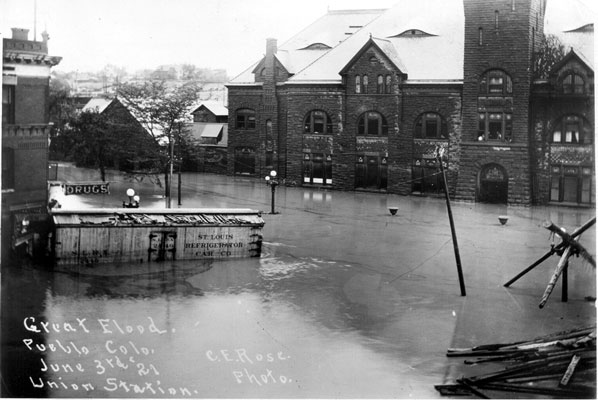
June 3, 1921 - "The Great Flood"
Disasters
The 1921 Pueblo, Colorado, Flood
On June 3, 1921, there was a sudden cloudburst ten miles west of Pueblo, Colorado. The always-volatile Arkansas River began swelling. About the same time, there was a downpour over the Fountain River 30 miles north. The two rivers meet in the heart of town. The waters rose to over 15 feet in some areas. When it was over, nearly 1,500 people were dead and damage to homes and businesses was widespread. Property loss was estimated to be over $20 million (in 1921 dollars). The flood covered over 300 square miles.
Telephone service suffered, too. Damage to Mountain States lines and plant was estimated at $200,000. All toll lines were rendered useless, and more than 7,000 telephones were out of commission. The basement of the telephone building was filled with mud, and 9 1/2 feet of water flooded the first floor terminal room.
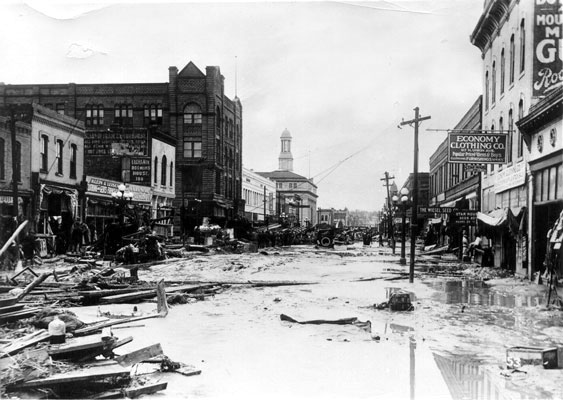
The aftermath - looking south along Union Avenue (THG file photo)
Two employees (Thady and Chief Operator Mrs. Josephine D. Pryor) received individual Vail Medals


Definition
The Vail Medal
The Vail Medal was created in 1920 in memory of Theodore N. Vail (President of the American Telephone and Telegraph Company from 1907 to 1919) to perpetuate his ideals of service to the public. The medal, which bears his likeness, was awarded to individuals for noteworthy acts reflecting the Bell System's highest traditions of loyalty and devotion to duty.
Adolph Alexander Weinman, one of the leading sculptors in the United States, designed the Vail Medal in 1921. In designing the medal, Mr. Weinman captured not only the personality of Vail, but also his ideals of service to the public.
The face of the medal bears a portrait of Vail, while on the reverse, the central figure represents the "Civilizing Force of Communication" speeding the winged message along the wires. At the right, "Loyalty to Service" upholds the left hand of the central figure, while a third figure, "Devotion to Duty," helps to support the lines of communication.
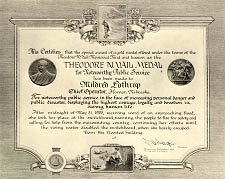 There are three types of Vail Medals: bronze, silver, and gold. Bronze medals were awarded to individuals in each Bell System company by that company's awards committee. A Bell System Committee then reviewed these cases and selected those of "especially outstanding excellence or importance" for silver or gold medal awards.
There are three types of Vail Medals: bronze, silver, and gold. Bronze medals were awarded to individuals in each Bell System company by that company's awards committee. A Bell System Committee then reviewed these cases and selected those of "especially outstanding excellence or importance" for silver or gold medal awards.
A bronze medal was also awarded to groups of employees where the noteworthy act was due to the concerted action of the group, rather than by an individual.
An embossed citation certificate, with a brief description of the circumstances that occasioned the award, was given to each Vail Medal recipient. (The one pictured is Millie Lothrop's.) A bronze plaque commemorating the act was presented to the company concerned. These plaques were designed for display in telephone buildings as a permanent and public memorial. Plaques may be seen to this day in telephone company buildings across the nation.
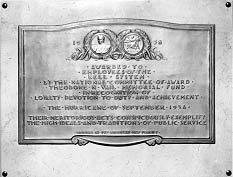 Up to the breakup of the Bell System in 1984, hundreds of awards were made to telephone company employees who embodied the ideal of service (see Heroes for some representative stories). Men and women of the Bell System performed acts of public service and bravery ranging from struggling through a blizzard to fix a downed line; saving a child from a burning building or a man from a raging flood; to staying at the switchboard while bullets flew—and were celebrated with the award of a Vail medal.
Up to the breakup of the Bell System in 1984, hundreds of awards were made to telephone company employees who embodied the ideal of service (see Heroes for some representative stories). Men and women of the Bell System performed acts of public service and bravery ranging from struggling through a blizzard to fix a downed line; saving a child from a burning building or a man from a raging flood; to staying at the switchboard while bullets flew—and were celebrated with the award of a Vail medal.
DISTINGUISHED SERVICE – PUEBLO FLOOD
Because of the invaluable service rendered the public, and the unswerving loyalty shown our company during and shortly following the destructive flood at Pueblo, Colorado, June 3, 1921, this tablet of honor is gratefully dedicated to you and to your co-workers who bravely stood the test which none but strong hearts could have endured.
—Ben S. Read, President
The Mountain States Tel. & Tel. Co.
Additional Photos
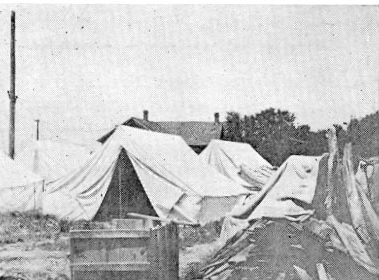
Telephone crews from around the state slept in tents at "P-Y Camp" (for N. O. Pierce, general plant manager, and major A.W. Young, who was in charge of all the clean-up crews) (from The Monitor, July 1921).
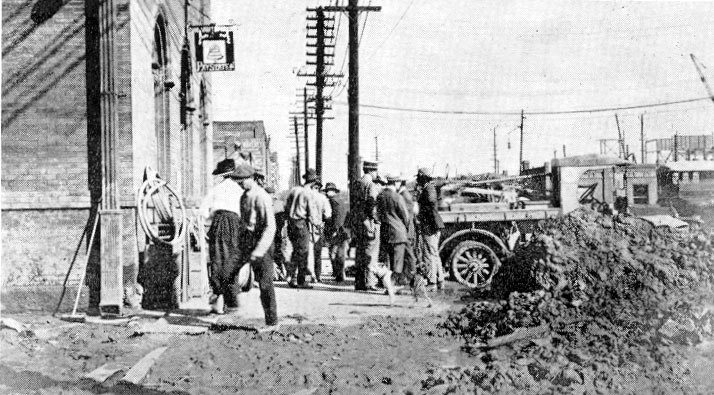
Three weeks after the flood - mud is still piled in front of the telephone office. Water came up to the Bell sign on the building (from The Monitor, July 1921).
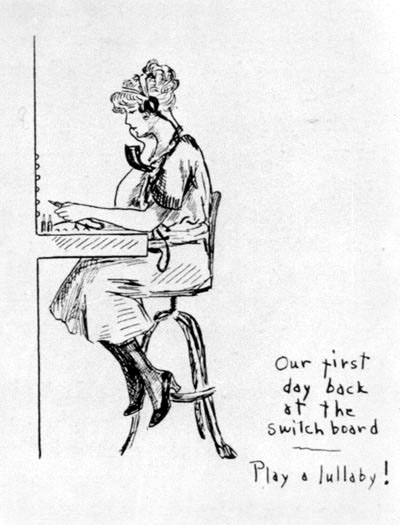
For more than a week after the flood, the exchange was operated out of a church, with only half of the operators working. "The girls" were happy to finally go back to work (sketch by Pueblo operator Wilma Cary).
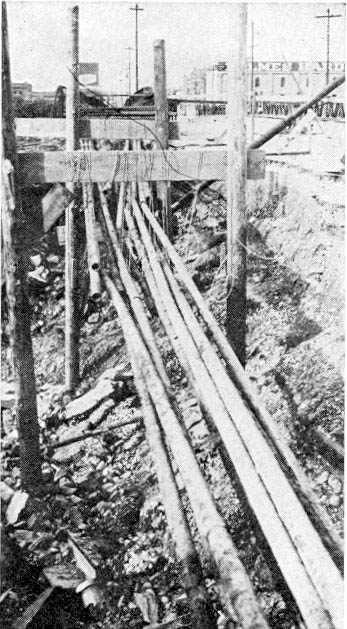
Underground cables exposed and wrecked by the flood (from The Monitor, July 1921).
Disasters
The 1921 Pueblo, Colorado, Flood
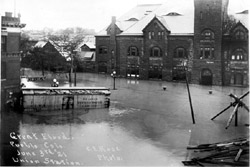
June 3, 1921 - "The Great Flood"
On June 3, 1921, there was a sudden cloudburst ten miles west of Pueblo, Colorado. The always-volatile Arkansas River began swelling. About the same time, there was a downpour over the Fountain River 30 miles north. The two rivers meet in the heart of town. The waters rose to over 15 feet in some areas. When it was over, nearly 1,500 people were dead and damage to homes and businesses was widespread. Property loss was estimated to be over $20 million (in 1921 dollars). The flood covered over 300 square miles.
Telephone service suffered, too. Damage to Mountain States lines and plant was estimated at $200,000. All toll lines were rendered useless, and more than 7,000 telephones were out of commission. The basement of the telephone building was filled with mud, and 9 1/2 feet of water flooded the first floor terminal room.

The aftermath - looking south along Union Avenue (THG file photo)
Through it all, Mountain States employees performed admirably. Operators stayed at their switchboards throughout the ordeal, providing comfort and emergency communication to the flood-ravaged citizens. Numerous instances of courage and heroism were reported (see Heroes – Byron Thady). The first people to arrive from outside the devastated area were telephone company employees. MST&T lost no time in sending crews from surrounding areas, but it took over a month to restore service to the entire town.
Two employees (Thady and Chief Operator Mrs. Josephine D. Pryor) received individual Vail Medals


Definition
The Vail Medal
The Vail Medal was created in 1920 in memory of Theodore N. Vail (President of the American Telephone and Telegraph Company from 1907 to 1919) to perpetuate his ideals of service to the public. The medal, which bears his likeness, was awarded to individuals for noteworthy acts reflecting the Bell System's highest traditions of loyalty and devotion to duty.
Adolph Alexander Weinman, one of the leading sculptors in the United States, designed the Vail Medal in 1921. In designing the medal, Mr. Weinman captured not only the personality of Vail, but also his ideals of service to the public.
The face of the medal bears a portrait of Vail, while on the reverse, the central figure represents the "Civilizing Force of Communication" speeding the winged message along the wires. At the right, "Loyalty to Service" upholds the left hand of the central figure, while a third figure, "Devotion to Duty," helps to support the lines of communication.
 There are three types of Vail Medals: bronze, silver, and gold. Bronze medals were awarded to individuals in each Bell System company by that company's awards committee. A Bell System Committee then reviewed these cases and selected those of "especially outstanding excellence or importance" for silver or gold medal awards.
There are three types of Vail Medals: bronze, silver, and gold. Bronze medals were awarded to individuals in each Bell System company by that company's awards committee. A Bell System Committee then reviewed these cases and selected those of "especially outstanding excellence or importance" for silver or gold medal awards.
A bronze medal was also awarded to groups of employees where the noteworthy act was due to the concerted action of the group, rather than by an individual.
An embossed citation certificate, with a brief description of the circumstances that occasioned the award, was given to each Vail Medal recipient. (The one pictured is Millie Lothrop's.) A bronze plaque commemorating the act was presented to the company concerned. These plaques were designed for display in telephone buildings as a permanent and public memorial. Plaques may be seen to this day in telephone company buildings across the nation.
 Up to the breakup of the Bell System in 1984, hundreds of awards were made to telephone company employees who embodied the ideal of service (see Heroes for some representative stories). Men and women of the Bell System performed acts of public service and bravery ranging from struggling through a blizzard to fix a downed line; saving a child from a burning building or a man from a raging flood; to staying at the switchboard while bullets flew—and were celebrated with the award of a Vail medal.
Up to the breakup of the Bell System in 1984, hundreds of awards were made to telephone company employees who embodied the ideal of service (see Heroes for some representative stories). Men and women of the Bell System performed acts of public service and bravery ranging from struggling through a blizzard to fix a downed line; saving a child from a burning building or a man from a raging flood; to staying at the switchboard while bullets flew—and were celebrated with the award of a Vail medal.
DISTINGUISHED SERVICE – PUEBLO FLOOD
Because of the invaluable service rendered the public, and the unswerving loyalty shown our company during and shortly following the destructive flood at Pueblo, Colorado, June 3, 1921, this tablet of honor is gratefully dedicated to you and to your co-workers who bravely stood the test which none but strong hearts could have endured.
—Ben S. Read, President
The Mountain States Tel. & Tel. Co.
Additional Photos
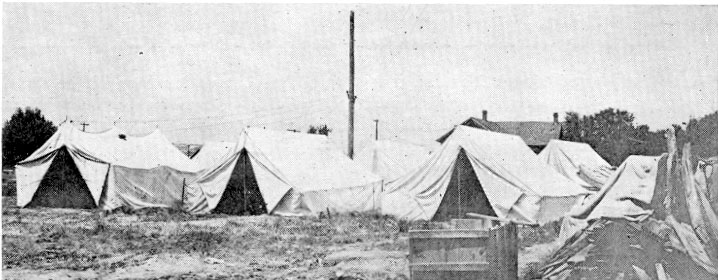
Telephone crews from around the state slept in tents at "P-Y Camp" (for N. O. Pierce, general plant manager, and major A.W. Young, who was in charge of all the clean-up crews) (from The Monitor, July 1921).

Three weeks after the flood - mud is still piled in front of the telephone office. Water came up to the Bell sign on the building (from The Monitor, July 1921).

For more than a week after the flood, the exchange was operated out of a church, with only half of the operators working. "The girls" were happy to finally go back to work (sketch by Pueblo operator Wilma Cary).

Underground cables exposed and wrecked by the flood (from The Monitor, July 1921).
back to top
back to Disasters
on to Mt St Helens